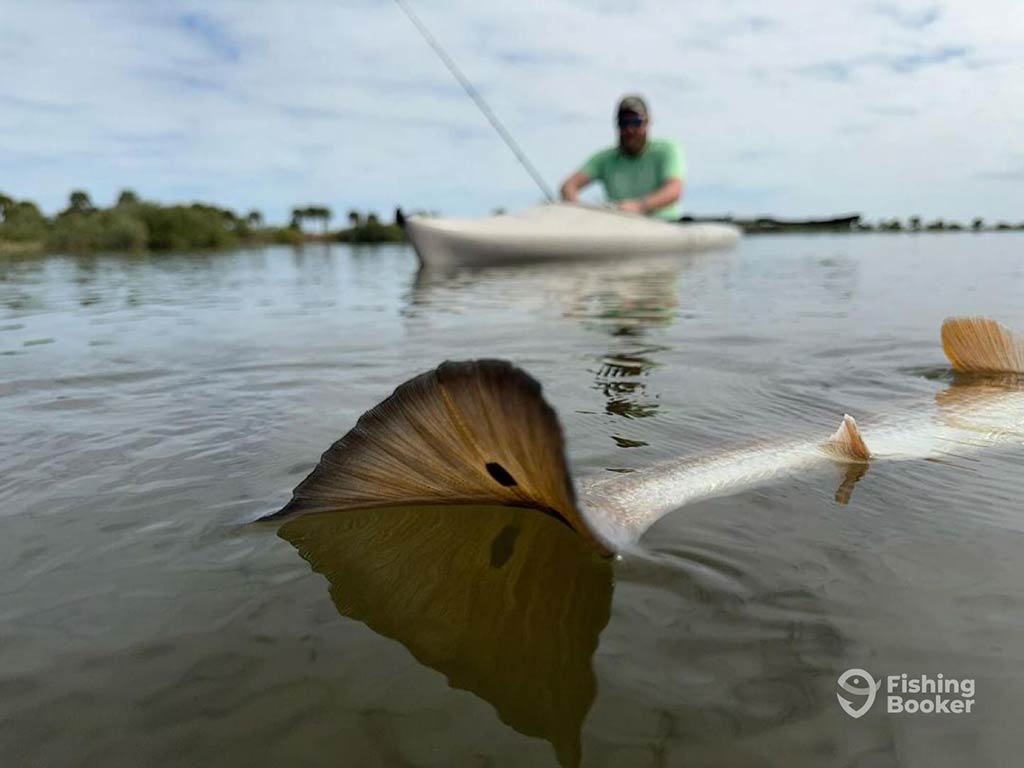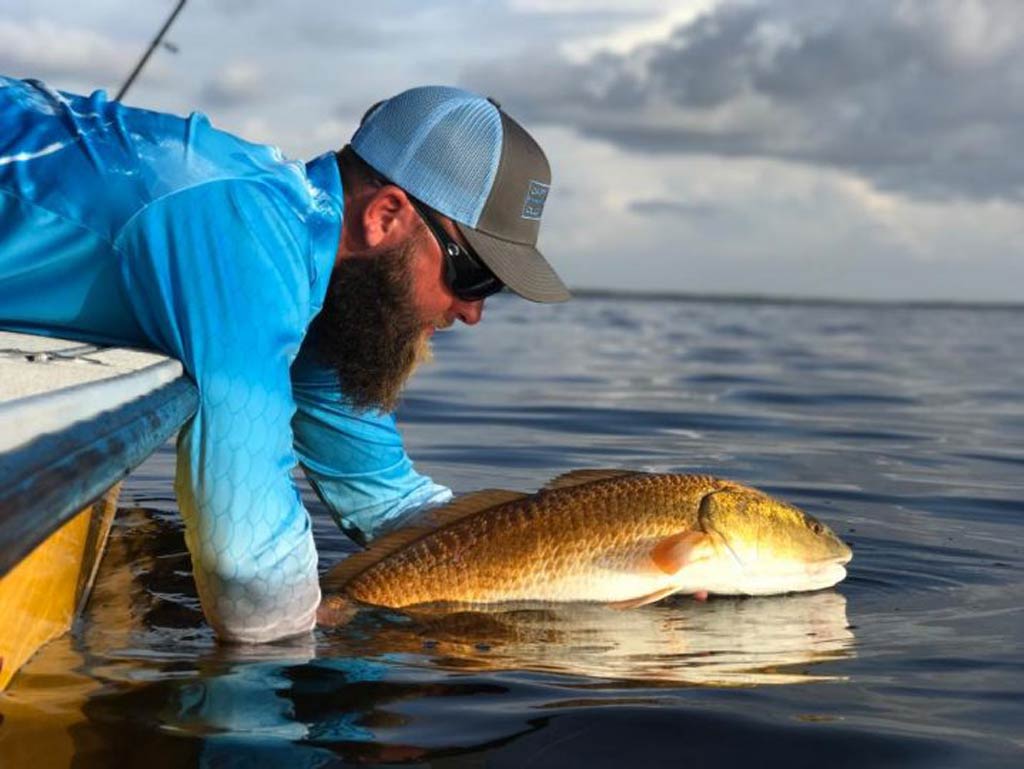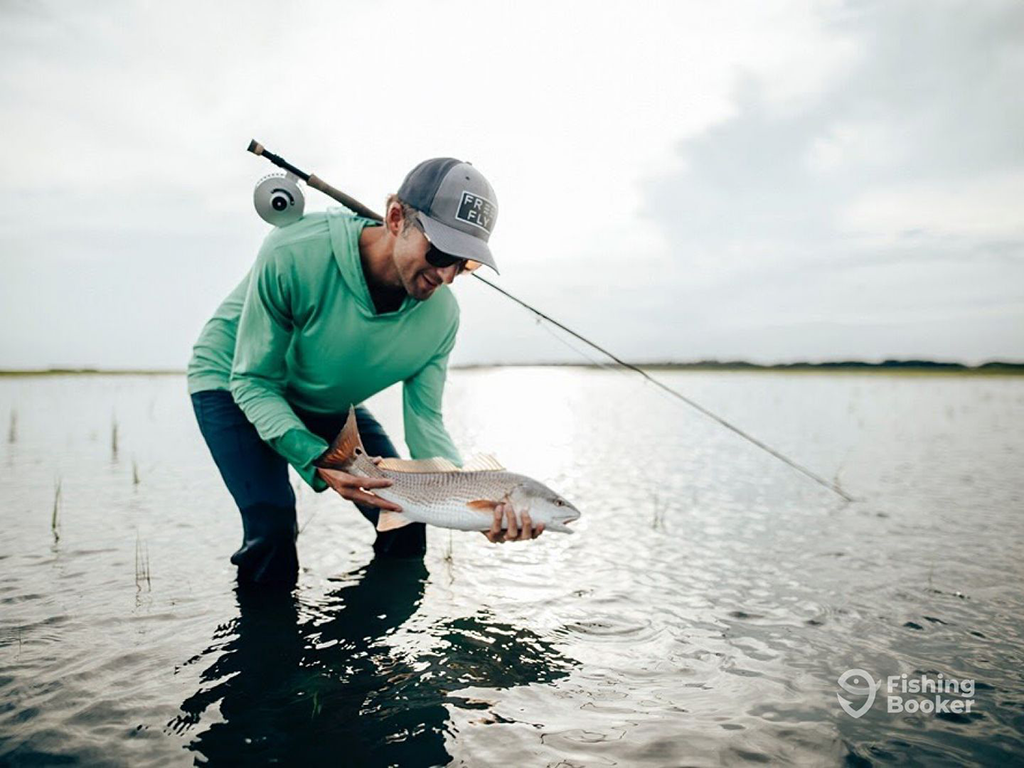Saltwater fishing in the American South wouldn’t be what it is without Red Drum and Black Drum. These heavy hitters got their name from the drumming sound they make, which will echo in your heart when the fight is on. Hook a trophy, and you’ll surely be beating your own chest. But when it comes to catching Red Drum vs. Black Drum, these fish couldn’t be more different.

Where one leads you to skinny water, the other hides under jetties and bridges. One is agile, the other relies on brute force. One will make a stunning photo, the other will outweigh everything else in your cooler.
So, in an honest-to-goodness, bent-rods Drum-off, who beats who?
Drum Species
First things first: What are Drum fish?
There are multiple species, including Red Drum (Sciaenops ocellatus), Black Drum (Pogonias cromis), Freshwater Drum (Aplodinotus grunniens), and Atlantic Croaker (Micropogonias undulatus). All of these belong to the family Sciaenidae. They got their common name from the croaking – or “drumming” – sound they make when their swim bladders vibrate.
Red Drum and Black Drum are the most common species. They inhabit many of the same inshore waters and you can catch them using similar gear. It’s common to encounter both on the same trip, which is why you might find yourself comparing them.
How to Identify Red Drum vs. Black Drum
When you look at Red Drum and Black Drum, you can tell they’re related. Both have large scales, broad faces, and flat tails. Their first dorsal fin forms a triangle, while the second one runs most of the way down their backs. But, you aren’t likely to confuse them with each other, thanks to several telltale signs…

Red Drum (aka Redfish, Channel Bass, or simply “Reds”) are easy to recognize, thanks to their copper color and signature black spot(s) near the tail. They usually measure 18–30 inches long, but can grow over 40 inches. These “Bull” Reds might weigh as much as 50 pounds or more!
True to their name, Black Drum are darker in color – usually gray or black. Mature fish don’t have any markings, but juveniles have vertical stripes, which make them look a lot like Sheepshead. Black Drum grow bigger than Red Drum, often topping 60 pounds. That’s nothing compared to a trophy-sized fish, which might get as big as 90 pounds!
Both species are good fun and good table fare. But Red Drum tend to poll ahead, despite the fact that Black Drum are bigger. This is due to their agility and stunning appearance. Red Drum also have an edge in the kitchen, thanks to the popularity of blackened Redfish recipes. Black Drum under 10 pounds make a decent meal, but bigger ones are often too coarse and wormy.
Lastly, you can hear the difference between these fish. Male Black Drum produce a deep, rhythmic sound – “drumming” – especially during the spawning season. Red Drum make less of a ruckus, which sounds more like croaking.
Distribution and Habitat
Red Drum and Black Drum share inshore waters along the US Atlantic coast and throughout the Gulf of America. You can find them from Texas to Florida and up to the Mid-Atlantic states.

While they inhabit the same places, they have slightly different lifestyles. Red Drum often cruise shallow flats, bays, estuaries, and surf zones. They love structure, but also roam open sandy or grassy bottoms. You’ll sometimes see them tailing in clear, skinny water, which makes them great sight fishing targets.
Black Drum prefer deeper inshore waters, especially when there’s hard or muddy bottoms where they can root around for crabs, clams, and shrimp. Mature fish take shelter around bridges, jetties, oyster beds, and channels.
Top Red Drum and Black Drum Fishing Spots
With all that in mind, the good news is that you can target both in many of the same places! Here are five spots to catch Red and Black Drum across the South and East coasts:
Louisiana Marshes

The marshes near Venice and Delacroix are teeming with Red Drum and Black Drum. The best time to fish for them is between September and January, especially before the end of the year, when you have a high chance of catching both.
Mosquito Lagoon, Florida
Don’t let the name put you off – this shallow lagoon near New Smyrna Beach is famous for its clear water. That makes Mosquito Lagoon an excellent spot for sight fishing. Fall and spring are the best times to target Red Drum here.
Galveston Bay, Texas

Galveston Bay offers unbeatable action when it comes to both Red Drum and Black Drum. You can catch them here year-round near local jetties, bayous, and marshes.
Cape Lookout, North Carolina
To the north, you can catch both fish around Cape Lookout, NC. Red Drum fishing peaks here in late summer, with huge schools of Bull Reds cruising the surf, while Black Drum swim in the estuaries and inlets.
Chesapeake Bay, Maryland/Virginia

In summer, the lower Chesapeake Bay sees its share of Bull Red Drum, especially near the Bay Bridge Tunnel. On the Eastern Shore, Black Drum will be spawning in the months leading up to that.
When to Fish for Red Drum vs. Black Drum
While we’ve given you an overview of some of the best times to target Red and Black Drum, there’s pretty much never a bad time to go after them. Neither species is migratory, so you can count on catching them in their home estuaries all year round. One thing to have in mind, though, is their individual spawning seasons.
Black Drum spawn ahead of Redfish, beginning in late winter and lasting through early spring. During this period, they swarm deep bay channels and gather near estuary mouths. Get lucky, and you may see massive schools of 40–60 lb Drum swirling beneath the water surface.
Meanwhile, Red Drum spawn in late summer and early fall, usually in nearshore waters just outside of a bay or estuary. You’ll see large schools of Bull Reds pushing bait fish to the surface, causing a lot of commotion.
Red Drum vs. Black Drum Behavior
To catch these fish, you have to understand their behavior. And, in this case, they really do dance to the beat of their own drum.

Red Drum behave like predators, stalking the shallows in search of their prey. They often travel in schools and hunt during daylight. Ask anybody who fishes for them, and they’re sure to tell you there’s nothing like sight fishing for tailing Reds. This is when they dig their snouts into the flats and their tails stick up out of the water, like little flags.
When Redfish hit your bait, it’s fierce. And when you hook one, you can expect some acrobatics. There will be sharp turns, erratic dashes, and all-out bursts of speed.
Black Drum, by contrast, are foragers. They swim near the bottom and root through mud and sand for crustaceans. They typically feed in low light, whether that means seeking out turbid water by day or hunting under the cover of night.

They won’t lunge at your bait like Redfish, but they do pull hard. What’s more, Black Drum tend to bulldoze their way to structure once you hook them. Their slow and steady runs will have you playing tug of war, whereas Redfish keep you on your toes with many twists and turns.
Clearly, these fish fight very differently. If you have the chance to target both in one trip, you’ll get a real sampling of Red Drum vs. Black Drum action.
How to Fish Red Drum vs. Black Drum
On that note, let’s gear up to catch one of these. They don’t necessarily require different rods or reels, but you’ll want to swap out some of your bait and lures if you plan on targeting both. What’s more, you’re going to rely on a totally different set of techniques.
Targeting Red Drum

In case you didn’t guess by now, Redfish are excellent targets on light tackle and fly gear. However, sight fishing is the most exciting way to zero in on them. On a sunny day with little to no wind, you’ll spot Redfish in clear, shallow waters. Cast ahead of the fish using a soft plastic or weedless lure. If you’re fly fishing, be sure to strip slowly. Keep your movements subtle to avoid spooking the fish.
If you don’t have the finesse for sight fishing, there are easier ways to catch Red Drum. It’s just as common to cast popping corks rigged with shrimp, mullet, or pinfish. For the most success, use this technique near grass edges, oyster beds, and tidal creeks.
You can cast plenty of artificial lures, as well. These tend to be most effective in grassy areas and murky water. Soft plastics like paddle tails, jerkbaits, and shrimp imitations work great when fished along the bottom. On the other hand, topwater plugs produce explosive strikes, especially if you fish them early or late in the day during summer.
Don’t be afraid to try some flashier lures, especially when the water is really dirty. This is when you can catch a Red Drum’s attention by adding a little fish oil or even using lures that rattle. Trolling with spoons is also very eye-catching. Use gold spoons in low light or murky water, and silver spoons when conditions are clear.
Targeting Black Drum

As we mentioned, Black Drum are bottom feeders. This makes bottom fishing the go-to method. And don’t bother with anything but natural bait!
Tie a Carolina rig with some clams, mussels, peeled shrimp, blue crab, or cut bait such as mullet or menhaden. Then, cast your bait near any structure that Black Drum love, like docks, jetties, pilings, bridges, and oyster bars.
The key is to let your bait “soak.” Black Drum may be brutish, but they’re also timid compared to Redfish. They tend to pick at your bait before committing to it, so if you feel some tapping on the end of your line, don’t set the hook right away.
In deeper water, such as bay channels, anglers sometimes chum for Black Drum using crushed clams or crabs. This draws them toward the boat, at which point you can cast down to them as you normally would.
It’s not very common to target Black Drum using artificials, but they can help you catch juvenile fish. Soft plastics that imitate shrimp supposedly work well for this if you’re fishing in warmer months.
Red Drum and Black Drum Fishing Gear

Everybody has their own favorite setup, but here are some pointers to get you started:
Fly fishermen can catch Red Drum using a 7–9 wt rod with floating or intermediate line. Top flies for Redfish include crab patterns, shrimp imitations, and clouser minnows in tan, olive, and copper.
If you’re more partial to spinning gear, you can catch both of these fish using a 7–7½’ fast-action, medium spinning rod. Pair that with a 2500–4000 size reel and 10–40 lb braided line. You might also add a 20–40 lb fluoro leader. 2/0–4/0 circle hooks are usually fine, though you might want a bigger hook if you’re after trophy fish.
The heavier end of the spectrum here is for Black Drum, which grow larger. If you’re in the market for a really big one, level up to a slightly bigger rod and 40–80 lb line. In fact, you can target trophy Black Drum using similar gear to what you’d use for Tarpon or big Catfish!
Red Drum vs. Black Drum: The Beat Goes On

So, Red Drum vs. Black Drum… What’s the verdict? It depends on what kind of fight – and flavor – you like. Redfish are feisty predators with wicked agility, which makes them perfect for fly fishing. Black Drum are far less glamorous, but they pack on the pounds, and hauling up a big one is definitely worth some bragging rights.
We know that either one of these fish will drum up some excitement for you. Luckily, you don’t have to choose: time your trip right, and you’ll reel in both. That’s gotta be music to your ears!
Are you a keen Red or Black Drum angler? What are some of your favorite techniques? Let us in on all your secrets in the comments below!
